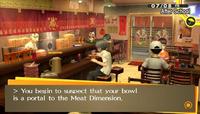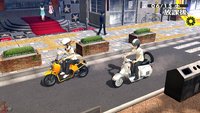|
|

|
PLATFORM
|
Vita
|
BATTLE SYSTEM
|

|
INTERACTION
|

|
ORIGINALITY
|

|
STORY
|

|
MUSIC & SOUND
|

|
VISUALS
|

|
CHALLENGE
|
Moderate
|
COMPLETION TIME
|
More than 80 Hours
|
|
OVERALL

|
+ New social links fix major pacing & plot issues.
+ A whole extra month to enjoy.
+ Battle additions make combat more exciting.
+ Excellent new songs on the soundtrack.
+ New events and activities during the year.
- Some of Rise's new abilities are too powerful.
|
Click here for scoring definitions
|
|
|
It should come as no surprise to anyone that Persona 4 Golden is a terrific game. It would take an unprecedented failing on virtually every level to screw up what has become one of Atlus's most beloved gems. Spawning both a fighting game sequel and an anime adaptation, Persona 4 is one of Atlus's most successful titles to date, and this PlayStation Vita port of the PlayStation 2 original will provide even more people the opportunity to experience it. However, what may come as a shock is that Persona 4 Golden is not only a great port, but it's actually a better game. Thanks to new mechanics and some extremely important additions to the story, the game plays and flows better than ever before. While it doesn't go to such extreme lengths as Persona 3 Portable, the upgrades are numerous and significant enough that this review will be dedicated primarily to them. For more detail on the game's core mechanics, RPGamer has numerous reviews of the PS2 original for you to peruse.
For those not in the know, Persona 4 Golden follows the exploits of a group of zany Japanese high-schoolers in the sleepy rural town of Inaba over the course of one school year. Players take on the role of a new transfer student who's moved from the city to live with his uncle and cousin for a year. Shortly after his arrival, two back-to-back murders shock the quiet villa, while at the same time strange rumors of a mystical television channel that can only be seen on rainy nights begin to circulate. The protagonist and his new friends soon discover a link between the two, and after discovering that they've somehow acquired the ability to physically enter television screens and explore the mysterious world that exists within, they take it upon themselves to solve the case. Over the course of the year, the protagonist must then delve into the TV world to rescue the kidnapped victims of the unseen culprit, while simultaneously balancing friends, school, and part-time jobs like any other high school student.
Each day, players must make decisions about what to do and who to spend time with. As the protagonist forms relationships with people in the game, he builds up new social links, advancing each character's personal story as well as providing other benefits. Each new rank provides an experience bonus when creating new Personas, physical manifestations of a person's personality that can be used to battle the shadows that lurk within the TV world. When a character's social link reaches rank ten, it imbues upon the protagonist the ability to acquire a very powerful persona. There are a total of twenty-two social links in Persona 4: Golden, two of which are brand new to this version, and each is affiliated with a different Tarot arcana. Maxing out all of them over the course of the year is a difficult task indeed, so players will need to decide carefully whom they want to spend time with.
 The plot of Persona 5 revealed!
The plot of Persona 5 revealed!
|
|
Those who have read my review of Persona 4 may recall that I had many criticisms of the game's story, particularly about its weak ending. Some of the biggest and most pleasant surprises offered up by Persona 4 Golden, however, are several new scenes, most of them occurring during the game's two new social links, that enhance the story, provide much needed foreshadowing, and create a bridge between the jarring transitions in the case. The new Jester social link in particular provides some incredible insight into very important aspects of the game. The game's story has been extended halfway into February on top of that, actually making it longer than Persona 3 and providing players with a new dungeon to explore. The new story sequences aren't simply inserted near the end, but carefully placed throughout the entire script, to the point where it's impossible to tell that they weren't there to begin with. These additions to the story are the biggest upgrade this version has to offer, and provide more than enough reason for Persona 4 veterans to return to Inaba one more time.
Of course, the improvements don't end there; the gameplay has seen a few tweaks and adjustments, most of them fairly minor, but all of which enhance the overall experience. The shuffle time mini-game, which occurs at the end of many battles, has changed significantly. Players will now see several stationary cards in front of them, and can pick any one of them to keep. Positive bonuses range from experience boosts to skill cards to new personas. However, some cards, particularly ones with negative effects such as "Half Experience" or "No Money," grant players the ability to pick additional cards. By picking cards in the right order, it's possible to select every card on the screen, in which case a clear bonus is acquired. This bonus guarantees a shuffle time mini-game at the end of the next battle, and also allows players to immediately select three cards rather than just one. There are a lot of really clever tricks that can be pulled off with this system, and smart players will sometimes find ways to acquire every card without landing any penalties at all.
Players will also find that their allies in battle have many new abilities at their disposal. As the protagonist's social links with his party members improve over the course of the game, those characters will learn new skills that can be added to their persona's move list. Players now have full control over deciding which moves their party members keep and which they forget, making them much more customizable than ever before. Once January rolls around, players will even be able to upgrade their allies' personas to a third, final level, which is accompanied by a brand new, incredibly powerful, and totally unique skill. Rise's new abilities are of particular note; she has gone from being an extremely helpful support character to being a virtual God with unrivaled power. By the time her persona has reached its ultimate form, she will be capable of displaying every one of an enemy's weaknesses and resistances simply by looking at it, will be able to revive the protagonist from death once per battle, will sometimes bolster the damage of all-out attacks, and will randomly cast buffs, restore HP and SP, and cast power and magic charge on the entire party. On occasion, she will even completely block certain attacks.
It's not only combat that has seen mechanical upgrades. Players have many more options when deciding what to do during each day. Midway through the game, players will acquire a scooter license which grants access to two new areas, both of which have unique activities. A coffee shop in Okina City allows players to extract skill cards from their personas, a mechanic transferred from Persona 3 Portable, and players can also see a movie with their friends and accept new quests. The beach offers a few other options, the most notable of which is a new spot to fish. The fishing mini-game has also undergone a major upgrade, requiring real interaction rather than just button-mashing. The scooter comes into play during battle as well; once its license has been acquired, even characters not in the player's active party will sometimes perform their follow-up attacks, riding into battle and attacking in a variety of amusing ways.
 Scooters. Yes, scooters. Why scooters? Why not scooters?
Scooters. Yes, scooters. Why scooters? Why not scooters?
|
|
The protagonist can now go out to the shopping district at night, which has its own new features. Three of the game's part-time jobs are only available at night, two of which include their own social links. Players can also sometimes spend time with their friends at night; although social links cannot gain ranks during nighttime visits, they will increase quite a bit, so it can be useful when trying to maximize a particular character. The shrine can also be visited at night, where players can draw fortunes to improve the social links of anyone they wish. Finally, a book store has opened up in the shopping district, with a new selection of titles to choose from every month. The protagonist can spend time reading these books in his room at night, which have various effects depending on their topics.
By far the most exciting and ambitious upgrade to Persona 4 Golden, beyond the improved storyline, new social links, and fresh gameplay mechanics, is the introduction of passive online functionality. Rather than taking the StreetPass methodology of Nintendo, Persona 4 Golden instead introduces a system much akin to the functionality of Demon's Souls. By opting in to the online functionality, the game records data about individual play experience, which it then shares with other users. The upshot of this is simple: an icon on the top left corner of the screen allows players to see at a glance what a selection of other players did during that same day. Atlus used a similar system in its PS3/Xbox 360 game Catherine, but Persona 4 Golden exceeds it in scope by a great deal. This functionality can also extend to dungeon-crawling. Players can send out SOS signals to request aid from others, manifesting as a number of encouraging remarks and a nice HP and SP boost.
Persona 4 fans will also notice an impressive visual upgrade with the transition to the Vita. While it doesn't quite reach HD levels, the visual design is crisper and more vibrant than the PS2 original. In particular, everything seems clearer; more of the background is visible, and the streets don't seem like they're perpetually shrouded in haze (except when they actually are). The soundtrack continues to be one of Shoji Meguro's best, and new additions to the soundtrack enhance rather than supplement it, as was the case in Persona 3 Portable. In particular, the track "Snowflakes" stands out as one of the better new additions, and ought to find its way into all RPGamers' Christmas playlists.
Although Persona 4 Golden doesn't cram in as much new content as Persona 3 Portable did, it nonetheless continues the proud Atlus tradition of ports that go beyond a one-to-one copy. There's more than enough new content here to entice old players to revisit the game, and the extended story and new social links make it the definitive version for those new to the town of Inaba. Thanks to the recent release of Persona 4 Arena, it's also a particularly timely release. Players can expect to sink at least eighty hours into the game, if not more, and it's eighty hours well spent. Persona continues to be one of the best RPG franchises around.
Review Archives
|









